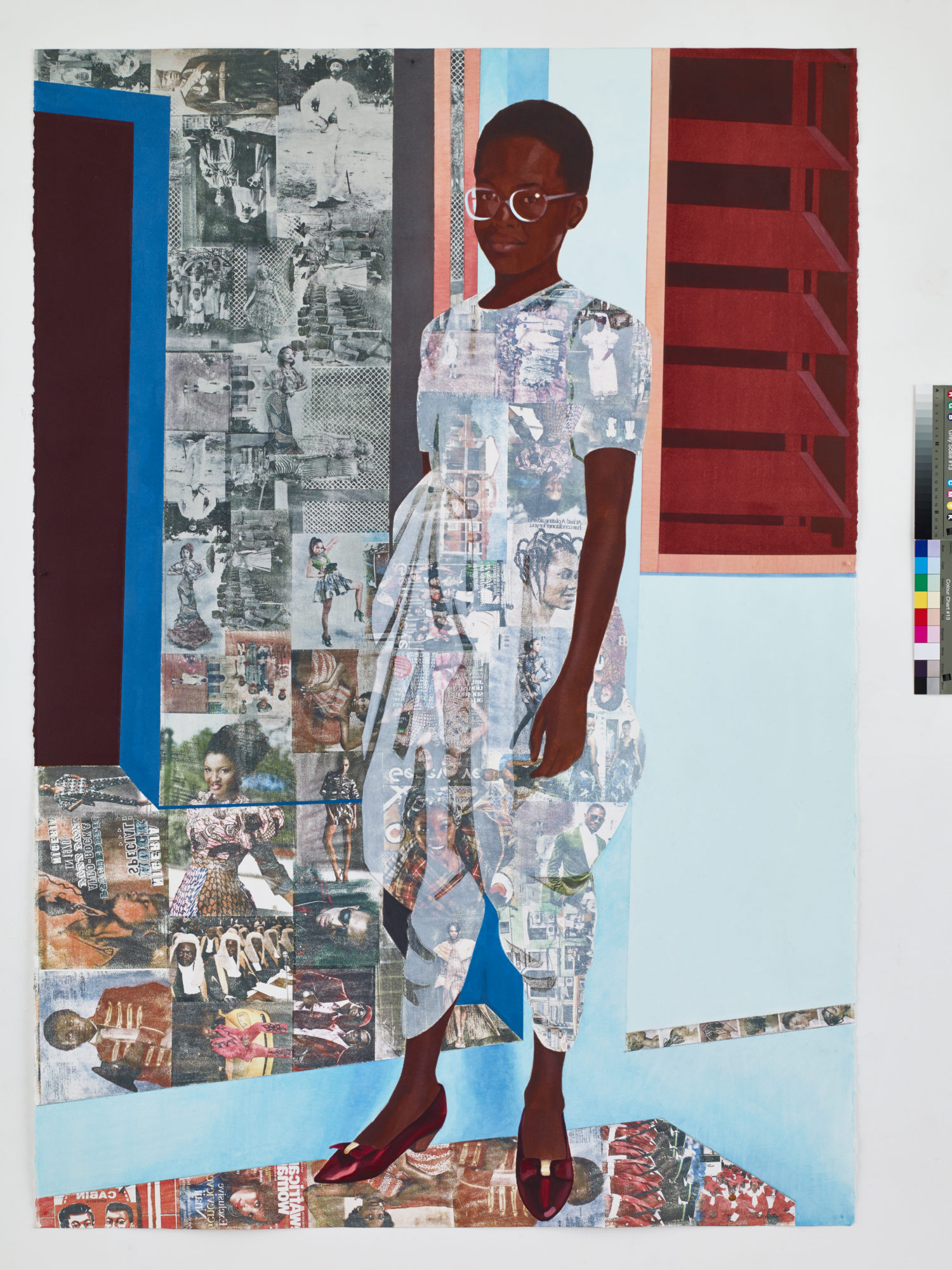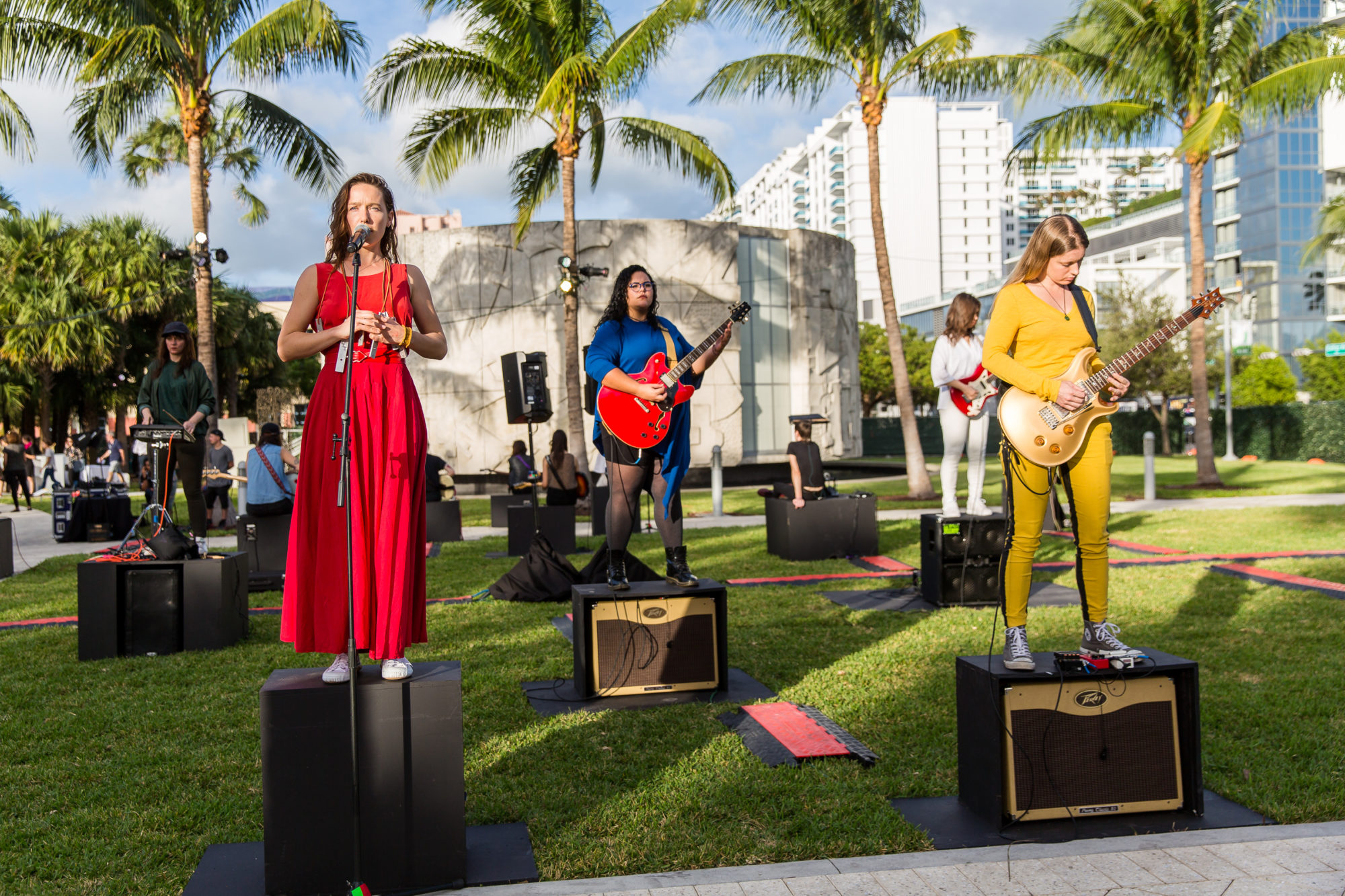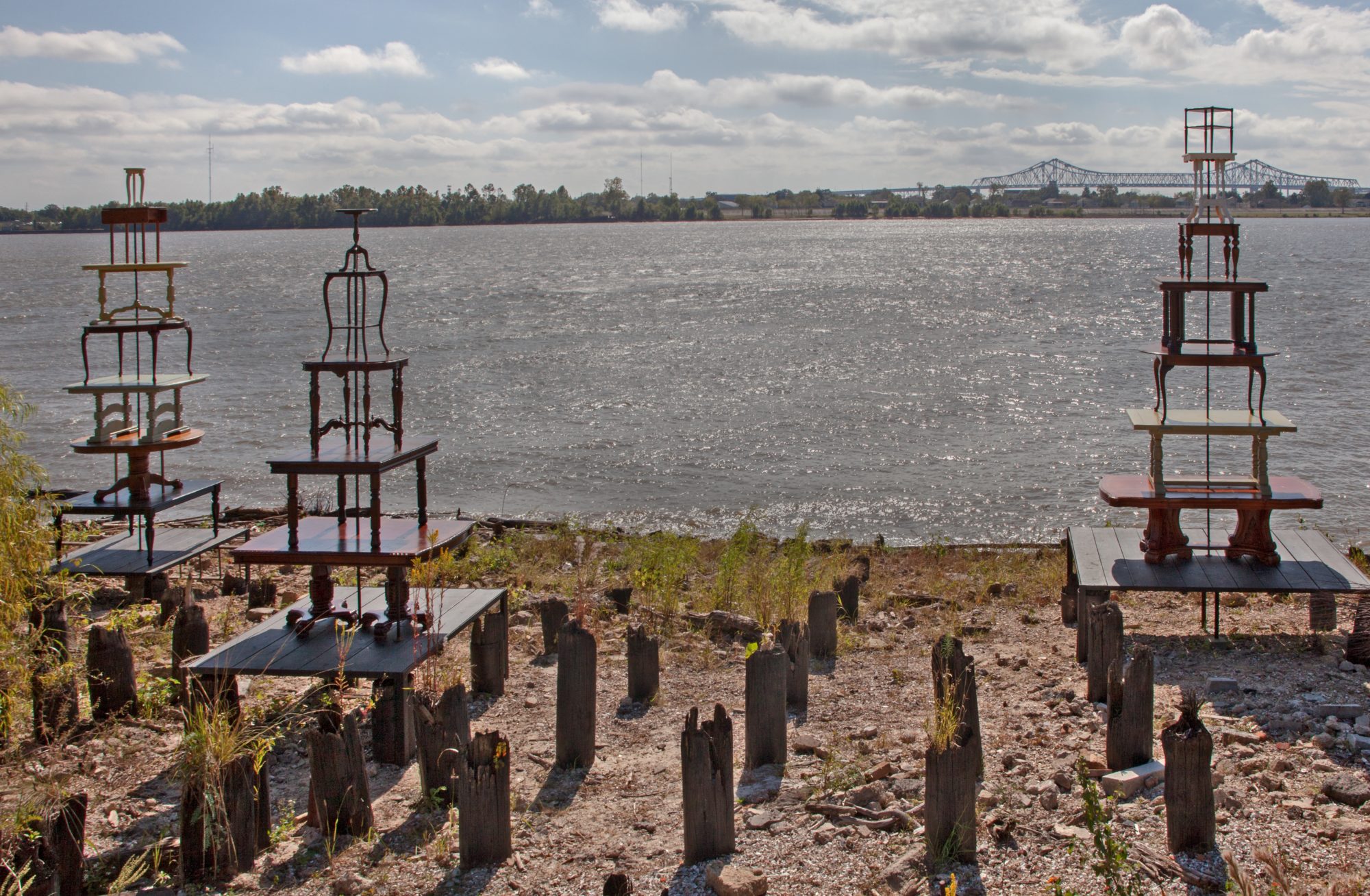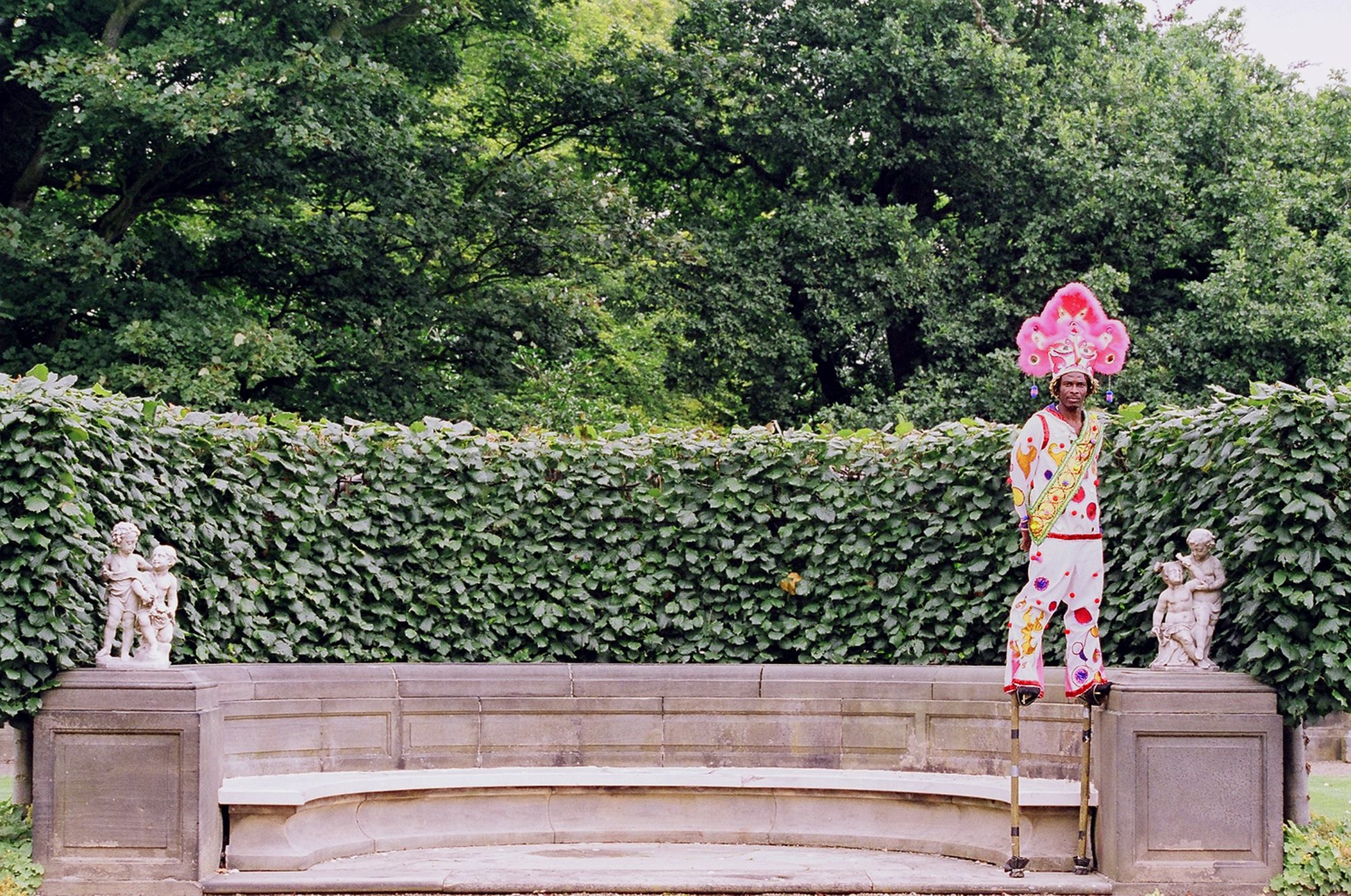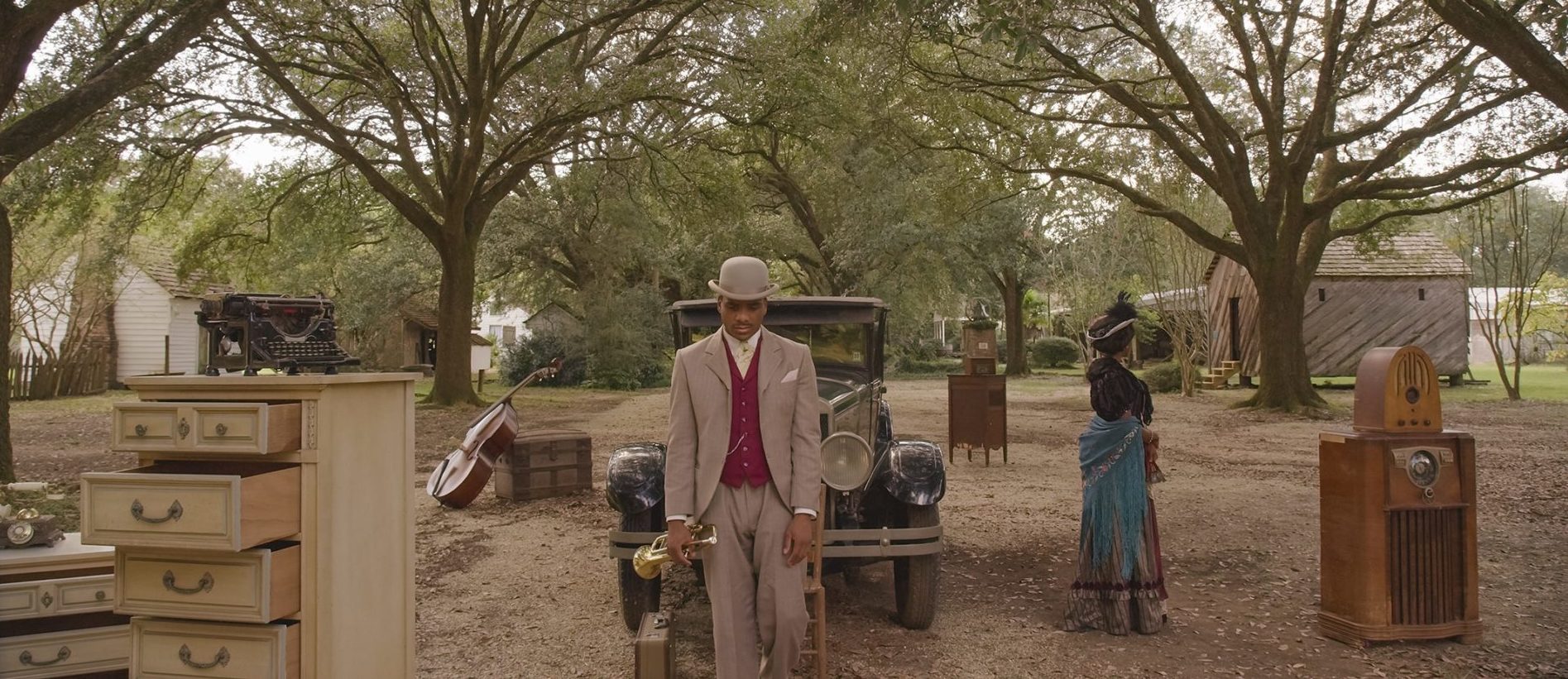
John Akomfrah, Precarity, 2017, three channel HD colour video installation, 7.1 sound, dimensions variable [courtesy of the artist, Smoking Dogs Films, Lisson Gallery]
Prospect.4:
The Lotus in Spite of the Swamp
Share:
When the first in November 2008, it premiered as a large-scale event in the tradition of the São Paulo or Venice biennials, but with a twist: Prospect.1 was scattered across a place still struggling to recover from America’s worst urban flooding disaster. Prospect founder Dan Cameron had assembled an array of global art stars whose seductive works lent an unlikely aura of chic spectacle to a city where some neighborhoods were still ghostly ruins. Fast-forward almost a decade, and Prospect.4 (P.4)—now officially a triennial—takes place in a much changed city, nation, and world, where the only constant is the looming threat of chaos. The exhibition’s title, The Lotus in Spite of the Swamp [, reflects an ancient Buddhist notion of how the swamp’s chaotic murk is inseparable from the pristine lotus flower it hosts—an analogy jazz saxophonist Archie Shepp to describe how jazz evolved as an artistic response to the challenges of black history.
Under the leadership of artistic director Trevor Schoonmaker, curator of the Nasher Art Museum at Duke University, this iteration generally maintains Prospect’s traditional meandering trajectory, but unlike some recent big art shows, it mostly eschews spectacle and click-bait controversies in favor of works that reflect more meditative approaches to the human condition and 21st-century issues. Timed to coincide with the 300th anniversary of New Orleans’ founding, Lotus features an expansive array of works by 73 , most of whom are associated with the Global South nations of the Caribbean, Latin America, Africa, and southern Asia. It may seem odd that a city of the “Deep South” should be so linked with the Global South, but as Schoonmaker noted in a recent interview with Burnaway, New Orleans is both “the most European and the most African city in the United States”; the city is often called “the northernmost Caribbean city” for its seminal shared history with Haiti and Cuba, and its commonalities with places shaped by centuries of colonialism, otherness, migration, and the profoundly creative processes of creolization.
Much of what’s on view in Prospect.4 looks like “contemporary art,” yet the distinctive wide-reaching sensibilities of the Global South resonate below the surface. Works by 26 artists occupy the Contemporary Arts Center New Orleans (CAC) exhibition spaces, where occasional, terse critiques co-exist with lyrical works such dreamy collage paintings, in which women cohabit with spectral flora and fauna in synergistic new frontiers of the psyche.
Njideka Akunyili Crosby, The Beautyful Ones Series #1c, 2014, acrylic, color pencils, and transfers on paper, 61 x 42 inches [photo: Photographer Stephen White, image courtesy the artist and Victoria Miro, London]
A carnivalesque flair defines native Rina Banerjee’s fantastical found object sculptures that recall both Hindu processional pageants and Mardi Gras parades—events that share surprisingly similar origins in ancient rituals based on alternate realities where anything is possible. Such possibilities appear fulfilled in London-based Caribbean artist Sonia Boyce’s Crop video, wherein Moko Jumbie, the towering protector spirit of Barbados’ masked carnival, is transposed to Harewood House, an 18th-century English manor built with slavery profits from colonial plantations—a place that, in this work, has been liberated by Moko Jumbie and his supernatural accomplices. Exhibited nearby at CAC is Penny Siopis’ installation of artifacts from the Zulu warrior culture of her native South Africa, juxtaposed with items from the New Orleans traditional —including a video of 1949 king Louis Armstrong performing a composition inspired by its tribal antecedent.
Armstrong’s little-known work as a visual artist is showcased with a series of his collages exhibited at the New Orleans Jazz Museum at the Old U.S. Mint, a repurposed antebellum former federal building. Originally created to adorn the boxes that housed his massive collection of tape recordings, these works reflect the improvisational resourcefulness that enabled Armstrong’s rise from humble origins to become the most globally influential musician of his time. Music is a pervasive P.4 theme that reflects Schoonmaker’s view of jazz as “arguably the preeminent art form of the 20th century”—a sensibility echoed in musicological sculptural works, one by Berlin-based British Jamaican artist . Contrapuntal Afro-Caribbean rhythms appear in visual form in the extravagant beaded , one of many local marching societies whose mysterious chants and rituals have long honored the legacy of runaway enslaved black people and the Native Americans who sheltered them. The beat goes on in the classical white marble atrium of the New Orleans Museum of Art (NOMA), where P.4 visitors are greeted by Barkley Hendricks’ meticulous portraits inspired by late-20th-century —an introduction to NOMA’s host of P.4 works, by artists including Xaviera Simmons, Dawit Petros, and Njideka Akunyili Crosby, among others. Visual and audio atmospherics coalesce on the fifth-floor terrace of the Ogden Museum of Southern Art, where an enigmatic tubular sculpture by New Orleans visual artist//musician Quintron transforms shifting, weather-based atmospheric energies into hypnotic electronic music. A different atmospheric sensibility appears in New York-based Wayne Gonzales’ conceptual installation of traditional 19th-century New Orleans landscapes paired with contemporary scenes meticulously painted to resemble old news magazine photos from the artist’s Louisiana childhood.
Cultural space-time is further explored in artist John Akomfrah’s video —an evocation of the life of Charles “Buddy” Bolden, the legendary “founder” of jazz whose meteoric rise to fame ended abruptly with his 1907 institutionalization for schizophrenia. Bolden made no recordings, but Akomfrah, the Ghana-born, London-based winner of the 2017 Artes Mundi Prize, explores the musician’s world in gorgeously photographed flashback sequences that ebb and flow with quietly oracular voiceover ruminations. Akomfrah’s liminal, free-form sensibility subtly resonates with Yoko Ono’s large text painting on the Ogden’s outer wall: “HAVE YOU SEEN THE HORIZON LATELY?”
Installed across the river at Algiers Point is Mark Dion’s a cabin laboratory that is also a meditation on the quandary of scientists caught between the catastrophe of climate change and America’s culture of denial. As New Orleans’ 300th anniversary approaches, play the songs of the enslaved Africans for whom Algiers Point was a way station before their sale to slaveholders. Appropriately, the ferry to Algiers Point now flies a flag by Nigerian-born New Orleans artist Odili Donald Odita—one of 15 for P.4. Fusing minimalist abstraction with colors reminiscent of the Dutch batik patterns widely known as “African” fabrics—and thus evocative of colonial trade routes—these works symbolize Odita’s vision of a world where it is recognized that different cultures “need each other’s energy to exist in beauty and freedom.”
That sentiment embodies the essence of what has come to be called “creolization” in the cultures of the Caribbean, Louisiana, Latin America, and the Global South in New Orleans. What makes The Lotus in Spite of the Swamp unique among large American biennial and triennial exhibitions is the extent to which the participating artists reflect a sense of “otherness” as a phenomenon of vast creative potential, rather than as a sociological problem for Europe and America to “solve.” Creolization requires what Martinique’s late poet-philosopher Édouard Glissant called a “poetics of relation” that is open to new ways of seeing, new ways of being—new ways of understanding that the swamp and the lotus are ultimately inseparable.
D. Eric Bookhardt is a contemporary art and culture writer and essayist. A former research archivist at the Museum of Modern Art, he is a longtime contributing editor of ART PAPERS and art critic for Gambit Weekly in New Orleans. His publications include several books and museum catalogue essays as well as reviews and features for publications including Art News, Art in America, Utne Reader, Sculpture Magazine, and Public Art Review. He serves as president of the Center for Gulf South History and Culture and is the editor of the New Orleans Art Insider website.
